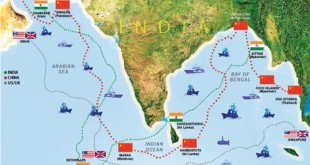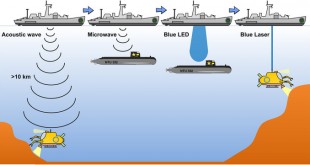Related Articles
Russia’s naval prowess has long been a focal point of global attention, and recent developments in its submarine fleet only serve to underscore its commitment to maritime dominance. The unveiling of the Emperor Alexander III and the upgraded Krasnoyarsk submarines exemplifies Russia’s dedication to enhancing its naval capabilities and maintaining strategic deterrence.
Beneath the icy depths and vast expanses of the world’s oceans lies a silent force shaping the global security landscape: the nuclear submarine fleet of the Russian Navy. This diverse fleet, a legacy of the Cold War and continuously modernized, serves as a crucial pillar of Russia’s strategic deterrence and maritime ambitions.
A Diverse Fleet: Nuclear Submarines in the Russian Navy
Russia’s submarine fleet encompasses a diverse array of vessels, ranging from attack submarines to ballistic missile and cruise missile submarines. Some of these submarines were inherited from the Soviet era, while others have been newly constructed to meet modern naval requirements. In total, the Russian Navy boasts an impressive fleet of 45 nuclear submarines, each playing a distinct role in bolstering maritime security and strategic capabilities.
At the heart of this underwater armada lie the ballistic missile submarines (SSBNs), silent sentinels armed with nuclear payloads. The Borei and Borei-A classes, boasting advanced quieting technology and carrying Bulava ballistic missiles, represent the cutting edge of Russia’s nuclear deterrent. These submarines patrol the oceans undetected, ready to unleash devastating firepower if needed.
Meanwhile, multi-purpose attack submarines (SSNs) like the Akula and Yasen classes prowl the seas with unmatched agility and firepower. Equipped with torpedoes, cruise missiles, and advanced sensors, they excel in anti-ship warfare, intelligence gathering, and special operations. Their ability to operate covertly grants them flexibility in diverse missions, from protecting strategic sea lanes to countering enemy submarines.
Beyond these traditional roles, the Russian Navy also boasts special mission submarines. Project 1851 Paltus, for example, serves as a mobile underwater research platform, pushing the boundaries of scientific exploration in the depths. Additionally, unique designs like the Belgorod, reportedly housing a mini-submarine capable of nuclear missions, hint at Russia’s potential development of unconventional underwater capabilities.
In a significant display of maritime strength and modernization efforts, Russian President Vladimir Putin recently presided over the ceremonial raising of naval flags on two advanced nuclear-powered submarines, Emperor Alexander III and Krasnoyarsk, at the Sevmash shipyard in Severodvinsk.
This event underscores Russia’s commitment to enhancing its naval capabilities, with President Putin emphasizing the strategic importance of these newly unveiled submarines during the ceremony. The Emperor Alexander III, part of the Borei-A project, and the Krasnoyarsk, an upgraded Yasen-M-class submarine, symbolize Russia’s dedication to advancing its naval powers and modernizing its fleet.
Emperor Alexander III: The Jewel of the Borei-A Project
At the forefront of Russia’s submarine fleet is the Emperor Alexander III, the latest addition to the Borei-A project. This fourth-generation nuclear submarine stands as a formidable force equipped with advanced missile and torpedo systems. Named after esteemed Russian military figures, the Emperor Alexander III plays a pivotal role in bolstering strategic deterrence and safeguarding national security interests.
Emperor Alexander III: A Technological Titan
The Yasen-III class, represented by the Emperor Alexander III, boasts cutting-edge technology and an arsenal of formidable weaponry. Its key features include:
- Unmatched Quieting: Advanced sound-dampening technologies make it one of the quietest submarines in the world, granting it a significant advantage in detection avoidance.
- Powerful Cruise Missiles: Armed with Kalibr-M cruise missiles, capable of striking both land and sea targets at long ranges, the submarine packs a heavy punch.
- Expanded Payload Capacity: Designed to accommodate additional weapons systems in the future, the Emperor Alexander III offers flexibility and adaptability.
Krasnoyarsk: An Upgraded Yasen-M-class Submarine
In addition to the Emperor Alexander III, Russia has introduced the Krasnoyarsk, an upgraded iteration of the Yasen-M-class submarine. This multi-purpose submarine has undergone significant enhancements to its electronic weapon systems and materials, further solidifying its status as a formidable asset in Russia’s naval arsenal.
Notable improvements include:
- Upgraded Navigation and Communication Systems: Improved situational awareness and secure communication ensure effective operation in complex environments.
- Enhanced Payload Management: The modernized systems enable smoother and more efficient handling of the submarine’s weaponry, including Bulava ballistic missiles.
- Lifespan Extension: The modernization program extends the operational life of the Krasnoyarsk, contributing to the overall longevity of the Borei-A class fleet.
The Krasnoyarsk embodies Russia’s commitment to innovation and technological advancement in maritime defense.
Versatility and Strategic Significance
The unveiling of these submarines at the Sevmash shipyard highlights Russia’s ongoing efforts in naval development, with the shipyard undertaking projects for building advanced submarines for the Russian naval forces. The Emperor Alexander III, equipped with missile and torpedo systems, represents a significant addition to Russia’s ballistic missile submarine fleet and contributes to strategic deterrence and national security. Similarly, the Krasnoyarsk, featuring enhancements to its electronic weapon systems and materials, further strengthens Russia’s maritime capabilities.
What sets Russia’s nuclear submarines apart is their versatility and strategic significance. Not only are they capable of executing traditional submarine missions with precision and stealth, but they also possess the capability to carry land nuclear cruise missiles, further augmenting Russia’s strategic deterrence capabilities. This versatility underscores the critical role that nuclear submarines play in Russia’s broader defense strategy.
These advancements in Russia’s submarine fleet carry significant strategic implications:
- Deterrence: The sheer size and sophistication of the fleet contribute to Russia’s nuclear deterrence posture, serving as a counterpoint to NATO’s capabilities.
- Anti-Access/Area Denial (A2/AD): The submarines’ stealth and firepower enhance Russia’s ability to restrict access to and control specific maritime regions during potential conflicts.
- Global Reach: The deployment of submarines allows Russia to project power and influence across vast distances, demonstrating its status as a major naval player.
Furthermore, major nuclear powers globally are focusing on deploying strategic weapons on nuclear submarines due to their ability to undertake extended deterrent patrols underwater indefinitely. President Putin’s announcement of plans for continued expansion, with more Borei-A-class strategic missile carriers and Yasen-M-class submarines scheduled for construction at the Sevmash shipyard, underscores Russia’s long-term commitment to bolstering its naval capabilities and maintaining its position as a formidable maritime power.
Looking Ahead: Russia’s Maritime Ambitions
As Russia continues to invest in its submarine fleet and maritime capabilities, the global maritime landscape is poised for continued evolution.
Russia’s submarine fleet is clearly undergoing a period of dynamic evolution. Future developments to watch include:
- Next-generation Submarines: Russia is reportedly developing even more advanced submarine classes, pushing the boundaries of technology and firepower.
- Arctic Focus: Continued emphasis on strengthening capabilities in the Arctic region, vital for securing strategic resources and trade routes.
- International Implications: The continued modernization of Russia’s submarine fleet, alongside developments in other branches of its military, will undoubtedly continue to shape the global security landscape and influence international relations.\
However, maintaining this diverse fleet presents challenges. Upgrading aging Soviet-era submarines alongside building new ones requires significant resources and technological advancements. Additionally, concerns arise regarding safety and nuclear proliferation, highlighting the delicate balance between deterrence and responsible stewardship.
With a steadfast commitment to innovation and technological advancement, Russia’s submarine fleet remains a force to be reckoned with on the high seas.
Conclusion:
Russia’s submarine fleet remains a crucial instrument of its naval power, showcasing its commitment to technological advancement and strategic deterrence. As the fleet continues to evolve, understanding its capabilities and motivations becomes increasingly important for navigating the complexities of global maritime security. As geopolitical dynamics continue to evolve, Russia’s naval ambitions are sure to shape the future of maritime security and strategic stability
 International Defense Security & Technology Your trusted Source for News, Research and Analysis
International Defense Security & Technology Your trusted Source for News, Research and Analysis



